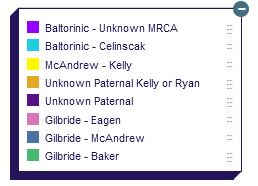Featured
- Get link
- X
- Other Apps
GENEALOGY CHALLENGE 2021 - DNA as Record
GENEALOGY CHALLENGE 2021
DNA as Record - January 18th entry of a 31-day challenge to post a document, photo or artifact on social media every day in January.
by Nancy Gilbride Casey
There is no more individual record of each of us than our DNA. Millions of testers have become much more familiar with these tiny bits of themselves by taking commercial DNA tests. Some are anxious to know about their ethnicity, others may want to know about their health. Some are searching for the answers to mysteries, or finding birth parents or children given up for adoption.
DNA is also a fantastic way for researchers to confirm their family tree or their "pedigree." It can help confirm biological links between generations which had previously been documented with traditional evidence like birth and death records, census records, etc.
Various DNA tools have been developed to allow us to visualize this powerful personal record. A chromosome browser is a tool available on some commercial DNA sites such as 23andMe and MyHeritage. Users can visualize and compare their DNA to their matches to see how much DNA they share, and on which chromosomes.
Below is 23andMe's representation of one of my DNA matches showing the segments we share in purple among the 22 chromosomes and the X chromosome.1 I was not sure of my relationship to the match at first - the "Second Cousin" relationship was a company suggestion. We share 221 centimorgans (cM) of DNA over 11 segments. I had the match's surname, but did not recognize it (for privacy reasons, I will not share it here).
Knowing the amount of shared DNA can predict which of relationship is possible, using a fantastic tool called the Shared Centimorgan Project, a reference of real-world examples of shared DNA in known relationships. In my case, the 221cM we shared suggested any of the relationships in the table below were possible; note that 23andMe's predicted relationship of 2nd cousin is also in the top group of predicted relationships here - 51% probability:2
A relationship of 2C would mean the match and I share a great grandparent; that of 1C2R (first cousin twice removed), that we share a great, great grandparent. I discounted the half relationships at first as none of my great grandparents or great, great grandparents had more than one spouse that I knew of.
Focusing on the descendants of these ancestral couples, I looked for the match's surname, and quickly realized that a great uncle's child married a person with my match's surname. A quick message to this match confirmed my suspicion; this was their child, and indeed my second cousin. Our "most recent common ancestor" is our great grandfather John Joseph Gilbride (1876-1937).
DNA can also be visualized with DNA Painter, a tool where shared segments of DNA can be "painted" onto a chromosome template. Eventually, if enough segments are painted, patterns may emerge showing how DNA segments have been passed from generation to generation on the same ancestral line, as they will likely overlap.
Below is an example of my "painted" chromosome with some of my known matches.3 The pale blue background are paternal side matches, the pale pink background are my maternal side matches:
 |
| This key shows the confirmed or possible common ancestors for my painted matches. |
This small sample of three matches on Chromosome 3 tells an interesting story.4 The green match is close paternal relative, with whom I share a great deal of DNA. The pink and blue are second cousins on my paternal side; I share less DNA with them as they are further away from me on the family tree. All are known Gilbride descendants.
The smaller portion where they overlap is called a "triangulated segment" meaning three or more matches share the same segment. Because I know the pink match and I share the common ancestral couple of my 3x great grandparents James Gilbride and Bridget Eagen, I can theorize that the triangulated segment which all four of us share may have been passed down through generations from either James Gilbride or Bridget Eagen.
These are just a few of the amazing advances in DNA tools which can help us understand our DNA. They can help us tell the story of our lineage on the most basic, biological level.
NEXT UP: Childhood Heirloom





Comments
Post a Comment